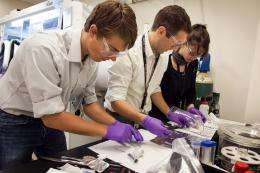Peering into protein dynamics

Young collaborators at Spallation Neutron Source chemistry lab prep proteins to take neutrons.
Two post docs and a doctoral student donned safety glasses and put their arms into a high purity, inert atmosphere glove box recently, to prepare protein samples for neutron scattering on the Cold Neutron Chopper Spectrometer (CNCS) at the Spallation Neutron Source (SNS) at the Deparatment of Energy's Oak Ridge National Laboratory.
The young collaborators were working in the SNS chemistry lab for Alexei Sokolov, who holds a joint University of Tennessee (UT)-ORNL Governor's Chair appointment in biophysics.
"This is work to understand protein dynamics," said Jonathan Nickels, a postdoc of Sokolov's at UT. "Anyone can look up the structure of a protein online now, there are so many databases. But that's just a freeze frame shot of the structure.
"Clearly structure and function are linked but there is a lot of missing depth to this picture. We need to know more about how these things move," he said.
Nickels, fellow postdoc Stefania Perticaroli from Italy, and doctoral physics student Max Heres, all from UT, did previous work on what is called green fluorescent protein (GFP), a protein first isolated from a jellyfish, that earned its discoverers a Nobel Prize in 2008.
Because it can be produced by living cells and is not toxic to other cells, GFP is now widely used in live cell fluorescence microscopy, where parts of a system under study can be marked with the protein, subsequently glowing green.
"Now we're expanding to compare other proteins to the green fluorescent protein," Nickels said. "We're looking at a couple of proteins with different structures and we want to compare the dynamics across different structural classes."
In this experiment, they are using picosecond (trillionths of a second) time lengths to study the dynamics of the proteins.
And so on a sunny Friday afternoon the three sealed their protein samples inside the glove box to reduced scattering from the air and then hydrated them with D2O, an isotope of hydrogen, to make them an ideal target for neutrons.
The next day, they began three days of measuring the neutron scattering spectra from the proteins, under the guidance of SNS instrument scientist Georg Ehlers. "And now after a good night's sleep we can begin our analysis of the data," Nickels said.
The students have already gathered data on the green fluorescent protein from neutron scattering at NIST and from the BASIS backscattering spectrometer at SNS. "This is our fourth iteration which gives us a continuing picture from different time windows," Nickels said. "We've gotten a very large dynamic window for GPF from the data we got at NIST and BASIS and we'll connect that with this work we are doing here."
They hope to publish a paper on their findings. Nickels said the work is fundamental to understanding how proteins move.
"We know the protein structure and we usually know what it does, but how does it do what it does? We know a lot about the chemical mechanisms, that they go through a transition state, and that if you position them the right way, they react. How does the protein motion contribute to the reaction? How does it couple that reaction into something productive?"
If they understand the basics, they can perhaps one day develop large scale industrial catalysts. "Nobody can design an enzyme from first principles. We can't do it. We know how to solve structures. There are really cool ways to solve binding problems. There are really cool chemistry approaches, virus libraries, yeast libraries, where you can design binding domains. "But being able to bind your two substrates does not mean you can force them to react. And all this is what we are trying to understand."
Provided by Oak Ridge National Laboratory



















